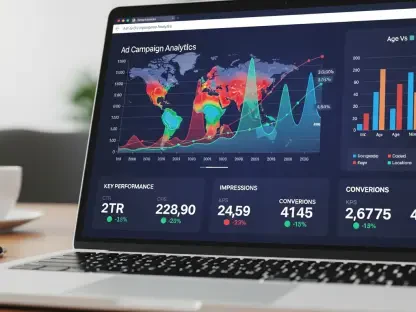The retail industry is undergoing a significant transformation driven by digital advancements. Mobile applications and data analytics are at the forefront of this change, enabling retailers to meet evolving consumer expectations and enhance the shopping experience. This article explores how these technologies are revolutionizing retail marketing, driving business growth, and shaping the future of the industry.
The Rise of Mobile Applications in Retail
Enhancing Customer Experience
Retail mobile applications have become essential tools for enhancing the customer experience. These apps are designed with user-friendly interfaces that allow customers to easily navigate product catalogs, apply filters, and view detailed product information with just a few swipes and taps. This seamless interaction not only attracts consumers but also keeps them engaged, making shopping more enjoyable and efficient. The convenience provided by mobile apps means customers can shop anytime and anywhere, leading to increased satisfaction and loyalty.
In addition to ease of use, retail apps often include features such as quick checkouts, wish lists, and personalized recommendations. These features make the shopping experience more tailored and pleasing for the user. For example, knowing a customer’s past purchases and browsing history can allow a retailer to make suggestions that the customer will likely find appealing. This high level of personalization can turn a one-time buyer into a repeat customer, thereby increasing the potential for future sales.
Personalization and Customer Engagement
By gathering and analyzing customer data, retail apps enable businesses to offer personalized shopping recommendations. This level of personalization engages customers more effectively and fosters brand loyalty by providing relevant suggestions based on their behavior and preferences. Personalized notifications, tailored offers, and exclusive deals further enhance customer engagement, making them feel valued and understood. When customers feel their needs are being anticipated and met, they are more likely to remain loyal to the brand.
Customer engagement is also bolstered through features like customer reviews and social sharing. These features enable shoppers to connect with other users, share their thoughts, and even showcase their purchases. This peer interaction can increase trust in a brand and influence purchasing decisions. Furthermore, retailers can leverage customer feedback from these interactions to continuously improve their offerings and better meet market demands.
Increased Sales and Revenue
Retail mobile applications help businesses achieve their primary goal of increasing sales and revenue. They offer a smooth, convenient shopping experience that encourages purchases. Many retailers also provide exclusive discounts and promotions via their apps to incentivize purchases and boost revenue. Additionally, data-driven insights from app usage allow companies to refine their marketing strategies and further enhance sales and income. By tracking user behavior within the app, retailers can determine which products are most popular, which promotions are most effective, and what improvements are needed.
Retailers can also use push notifications to alert customers about sales, new arrivals, or restocked items, driving immediate traffic and purchases. The ability to conduct flash sales or offer time-sensitive deals can create a sense of urgency, prompting customers to complete their purchases quickly. Over time, this consistent interaction helps keep the brand top of mind for consumers, making it more likely they will turn to the app for future shopping needs.
Trends Shaping the Future of Retail Apps
Cloud Infrastructure
The adoption of cloud infrastructure has surged in the retail industry, allowing retailers to expand and develop operations without the need for costly physical hardware. Cloud infrastructure supports hosting m-commerce websites and applications, storing and processing customer data, and managing payments and financial transactions. This scalability and flexibility are crucial for retailers looking to stay competitive in a rapidly changing market. Cloud solutions offer seamless integration and real-time data processing, which are essential for handling large volumes of transactions and data.
Moreover, cloud infrastructure enables better disaster recovery and data protection, ensuring business continuity. Retailers can quickly recover their systems in case of a technical glitch or cyber-attack, minimizing downtime and protecting sensitive customer information. The use of cloud solutions also allows for collaboration across different locations and departments, making it easier to implement company-wide strategies and innovations.
Integration of Novel Technologies
Integrating machine learning (ML) and artificial intelligence (AI) into retail apps has greatly improved the customer experience. ML algorithms assess consumer sentiment, while AI-powered chatbots provide personalized customer support. These technologies offer valuable insights and drive growth by enhancing the purchasing experience. Retailers can predict trends, optimize inventory, and deliver more relevant product recommendations, all of which contribute to a better shopping experience. AI can automate processes like customer service, freeing up human employees to focus on more complex tasks.
AI and ML can also help in detecting fraudulent transactions and preventing potential security breaches. By analyzing patterns and behaviors in transaction data, these technologies can identify anomalies and flag potential risks in real-time. This added layer of security is crucial for building and maintaining customer trust, especially as online and mobile commerce continues to grow.
Omnichannel Payments
As customers increasingly shop across physical, digital, and virtual channels, they expect a seamless experience that integrates their omnichannel habits. Retailers are responding by incorporating mobile technology into all channels, enabling customers to pay using mobile wallets, mobile payments, and loyalty benefits. This unified payment experience enhances ease of use, transaction speed, and security for all customers, making shopping more convenient and secure. The integration of various payment methods also allows retailers to cater to a broader audience, accommodating diverse preferences.
Furthermore, omnichannel payment solutions facilitate better tracking of customer spending and preferences, enabling retailers to offer more targeted promotions and rewards. This comprehensive view of customer activity across channels helps businesses create cohesive marketing strategies and improve the overall shopping experience. Advanced payment technologies like biometric authentication and contactless payments further enhance security and convenience for users.
The Impact of Data Analytics on Retail Marketing
Understanding Consumer Behavior
Data analytics plays a crucial role in understanding consumer behavior. By analyzing data from various sources, retailers can gain insights into customer preferences, shopping patterns, and purchasing behavior. This information allows businesses to tailor their marketing strategies, optimize product offerings, and create targeted campaigns that resonate with their audience. Detailed analytics help retailers segment their customer base more accurately and customize their marketing efforts for different demographics.
Additionally, data analytics can identify emerging trends and shifts in consumer preferences, enabling retailers to stay ahead of the competition. For instance, if a particular product category shows a sudden increase in popularity, a retailer can quickly adjust their inventory and marketing efforts to capitalize on this trend. This proactive approach helps businesses respond to market changes in real-time and maintain customer satisfaction.
Optimizing Inventory Management
Effective inventory management is essential for retail success. Data analytics helps retailers predict demand, manage stock levels, and reduce the risk of overstocking or stockouts. By analyzing sales data, seasonal trends, and customer preferences, retailers can make informed decisions about inventory, ensuring that popular products are always available while minimizing excess stock. Efficient inventory management leads to reduced costs and increased profitability by avoiding the expenses associated with unsold merchandise or emergency restocking.
Furthermore, data-driven inventory management can improve supply chain efficiency by ensuring that stock levels are optimized across various locations. This helps prevent situations where some stores are overstocked while others face shortages, providing a more consistent shopping experience for customers. Automated reorder systems can also be implemented using data analytics, streamlining the restocking process and reducing the likelihood of human error.
Enhancing Customer Retention
Customer retention is a key focus for retailers, and data analytics provides valuable insights into customer loyalty and satisfaction. By tracking customer interactions, purchase history, and feedback, retailers can identify areas for improvement and implement strategies to enhance customer retention. Personalized loyalty programs, targeted promotions, and exceptional customer service are just a few ways data analytics can help retain customers and build long-term relationships. Understanding what motivates repeat purchases enables retailers to create more effective retention campaigns.
Moreover, data analytics can help identify at-risk customers who may be on the verge of churning. By analyzing patterns such as decreased purchase frequency or negative feedback, retailers can take proactive measures to re-engage these customers. This might involve reaching out with personalized offers, addressing service issues, or providing incentives for returning. Ultimately, a deep understanding of customer behavior through data analytics allows retailers to foster stronger relationships and increase customer lifetime value.
The Future Outlook for Retail Apps and Data Analytics
Embracing Innovation
The future of retail lies in embracing innovation and staying ahead of technological advancements. Retailers must continue to invest in mobile applications and data analytics to remain competitive. Emerging technologies such as augmented reality (AR), virtual reality (VR), and the Internet of Things (IoT) will further transform the retail landscape, offering new opportunities for customer engagement and business growth. AR and VR can provide immersive shopping experiences, allowing customers to virtually try products before making a purchase, while IoT devices can offer real-time data and insights.
Innovative solutions like these not only enhance the customer experience but also open up new revenue streams for retailers. For example, AR and VR can create unique in-store experiences that attract more customers, while IoT devices can monitor product performance and customer interactions, providing valuable data for continuous improvement. Retailers that stay ahead of the curve in adopting and leveraging these technologies will be better positioned to meet and exceed customer expectations.
Adapting to Changing Consumer Expectations
As consumer expectations continue to evolve, retailers must adapt to meet their needs. Mobile applications and data analytics provide the tools necessary to understand and anticipate these changes. By staying agile and responsive, retailers can deliver personalized, convenient, and engaging shopping experiences that keep customers coming back. Timely and relevant communication, seamless omnichannel experiences, and tailored product offerings are some of the ways retailers can meet these expectations.
The ability to quickly adapt to consumer preferences also means that retailers can maintain a competitive edge in the market. As new trends emerge and customer demands shift, those who can pivot their strategies and offerings will be more successful in retaining and attracting customers. Continuous monitoring and analysis of customer feedback are essential in this process, as it allows retailers to make data-driven decisions and stay aligned with consumer needs.
Strategic Investment in Technology
The retail industry is experiencing a profound transformation driven by advances in digital technology. Mobile applications and data analytics are at the cutting edge of this shift, empowering retailers to satisfy changing consumer expectations and enhance the shopping experience. Businesses in retail are leveraging mobile apps to provide customers with more personalized shopping experiences, including targeted promotions and seamless interactions. Data analytics, on the other hand, offer invaluable insights into consumer behavior, allowing retailers to fine-tune their strategies and anticipate trends. This deep dive explores how these innovative technologies are revolutionizing retail marketing, facilitating business growth, and shaping the future landscape of the industry. With the rapid pace of digital innovation, retailers must adapt swiftly to stay competitive, meeting the consumers’ demands for convenience and personalized service. The adoption of these tools marks a significant shift in how retail operations are conducted, paving the way for a more interconnected and dynamically responsive retail environment.









